For many companies, Travel and Entertainment expense (T&E) is the second largest and second most controllable expense to manage. Organizations throughout the world are always looking for better ways to control costs and proactively manage their operations. And without a complete, accurate view of your travel expense data, it is impossible to make the best business decisions. The goal is to accumulate high efficiencies. Whether it is a streamlined process to save time or money, or to keep up with tax code changes, the job never ends.
Companies looking to find efficiencies and in turn, more money, hone in on a corporation’s second largest expense, T&E. At first glance, most CFOs and finance teams view T&E as a moving target, a necessary part of doing business with seemingly fluctuating costs. For most, that mindset and way of thinking is correct. Business needs change and T&E spends are at the mercy of travelers that support the business need or the supplier with changing fares and rates. And, most have implemented a travel policy for employees to follow. The real problem does not exist in the policies but in the ability to track action inside and outside of the policy parameters.
Do you know what your total Travel & Entertainment costs are?
Most CFOs immediate answer yes because these items can be shown as a line item in the P&L. However, the accuracy of the numbers can be questions, from the source to the analysis. The challenge is due to fragmented data, provided by many suppliers, and is never delivered by one source. For example, if your company works with a Travel Management Company (or companies) to provide travel services and support, they will have some of the data you need. Most companies leverage their TMC for reporting on the booked data but that data alone does not provide visibility into the true cost of the trip – it only reports what was booked and not necessarily the entire
spend. Things like;
- The total cost to stay at a hotel when an employee booked at one rate and for whatever reason, changes the accommodation.
- A cancellation with the preferred rental car supplier and the employee rebooked their preference.
- Meals and entertainment expenses accrued during travel.

These out of compliance variances in travel analysis are often not accounted in the cost analysis. Most companies will simply analyze volumes from their TMC or travel agency. Included in the analysis, finance teams will see true Travel and Entertainment expenses spread across a number of different travel expense platforms, from the TMC to the corporate card and expense systems.
The complexity of data between travel and expense systems makes consolidation the significant challenge. These disparate data sources take time and in many cases, the ability to pull data together correctly does not exist. The significant challenge not only accounts for the different data types but also in providing intelligent and actionable business intelligence to give CFOs the ability to make better decisions, based on metrics that can actually impact the top and bottom line.
Big data has become the new way to describe this data consolidation effort but for many, this is data for data’s sake. Leading corporate travel programs have advanced analytics and access to actionable intelligence where travel policy compliance can be measured by variance or leakage report, as well as true supplier contract management.
Do You Know How Many Travelers Booked Consistent With Your Travel Policy?
How often is the business unit, division or cost center information updated in your current reporting tool? Where do the policy violations take place? How much did it cost? Some corporations have been able to claw back hundreds of thousands by simply identifying and better managing exchange ticket fees or unused tickets. On an individual level, the costs represented are small ($75, $100, $150), but when they are rolled up and annualized across the enterprise, they can be very substantial. Even when tickets are purchased, the savings from having the right advance purchase policy in place can save thousands to millions of dollars.
“Organizations will continue to do more with less,
Best-in-Class organizations have outpaced the
industry by 67% in being able to keep
business travel spend under management.
These three key performance indicators,
allows a business to remain profitable
and competitive in the ever
changing T&E landscape. Companies actively
leverage analytics to gain intelligence
into key components of travel and expense management.”
–Aberdeen Group
Finding Metrics that are Proactive and Intelligent
Grasp Technologies maintains the right analytics tools and consolidation software, for data of all types to be brought together – from TMCs, expense systems, credit cards, telephony, accounting systems, HR and corporate hierarchies, open booking data, meeting management, general ledgers, CRMs and more.
Everything into One Consolidated Platform
Bringing everything together into one consolidated platform exposes the relationships between datasets and provides metrics that give insight into your entire travel program in a much more efficient manner.
- The true total cost of a company’s travel program
- Booked vs. billed data
- ROI across the entire travel program
- ROI on sales, accounting for travel and expenses (COGS)
- Breakdowns in the travel policy
- Ability to recognized best travelers and coach those not following T&E policy
The Aberdeen Group offers additional takeaways.
- Visibility is prime concern for the majority of organizations in regards to travel and entertainment expense management.
- Best-in-class organizations rely on internal attributes or capabilities, and a slew of technology solutions to enhance spend control and improve corporate policy compliance.
- Mobile applications and technology are considered a “link to the future” and will help both business travels and executives enact key T&E management processes via smartphones and tablet devices.
- Integration of key internal systems, including CRM, ERP, corporate card and event management, not only supports the greater good of driving visibility but also has relative benefits for sales, finance and marketing/event teams.
- Analytics is a prime means of enhancing travel and expense management visibility, gaining intelligence into the ROI of business travel and for understanding how this category effects greater business objectives.
Understanding the Challenges Inherent to Travel and Entertainment Expenses

The question to answer is how you find the right solution, put the right analytics and process in place to save money, save time and maximize your duty of care for your employees. Boiling that process down to key attributes is critical.
UNDERSTAND ALL OF THE MOVING PARTS.
Clarity of purpose is the most important and most essential element in developing a travel data
strategy. What types of data are you bringing together? And why?
UNDERSTAND DATA CONSOLIDATION.
Consolidating data takes effort and commitment as you and your provider will need to work
together to make things congruent across your different systems.
CHOOSE AN EXPERIENCE PARTNER WITH INHERENT KNOWLEDGE.
Because someone can consolidate data does not justify them as a good fit to partner with. It’s
important to intimately understand the types of data and how each relates to another to make
you consolidation successful.
MAKE SURE IT IS THE RIGHT TECHNOLOGY.
A partner must be able to demonstrate their capabilities and show you why their technology is
right. Can your partner make data consolidation seamless? Can they provide data visualization for
your needs? Does their solution require manual intervention? If so, why?
BE ABLE TO INTEGRATE CONSOLIDATION TECHNOLOGY & BI SOFTWARE FOR VISUALIZATION.
If a partner does not offer both, it will be much more expensive and cumbersome as companies
will have to work with multiple solutions that may have trouble integrating.
MAKE A COMMITMENT.
Putting a T&E solution in place to effectively manage your travel program takes work and requires
a commitment. That is not without rewards. Many companies who go through the process can
save upwards of 20 percent from their overall T&E spend – millions of dollars in many cases.
Not “IF”, But “WHEN” You Will Need This
If you have not already started to evaluate efficiency in this area of the business, now is a good time to start. It takes time to find the right partners and to put the right strategy in place based on your business’ needs. Consolidating from different data sources and selecting the right partner is critical to effective and proactive T&E expense management. Your business data will only become more and more difficult to manage with the fragmentation of different sources supplying disparate data sets.
Companies that choose to better manage their travel and entertainment program save significantly on resources and create a better experience for their employees. The return on your investment will be well worth it.
 Email This Post
Email This Post


